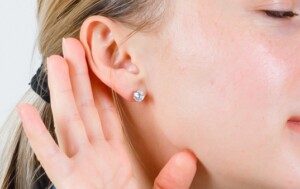Do you get an odd pain behind only one ear that seems to come and go without any pattern?
While it doesn’t feel like a headache, it’s definitely an ache that might make you wonder if it could mean something serious.
I had an MRA (an MRI that looks at blood vessels) of my head for an unrelated concern: pulsatile tinnitus.
Save for a suspected cause of the very subtle pulsatile tinnitus that I only occasionally hear overnight, my MRA looked “beautiful,” said the head/neck doctor.
The neuro-radiologist who read it also said that everything looked “unremarkable” – save for what was described as a possible benign deviation in the formation of the bulbous portion of my jugular vein (cause of the tinnitus).
So when I began having a more noticeable occurrence of this odd, on-and-off aching behind my left ear, I knew with absolute certainty that it wasn’t anything INSIDE my head (beneath the skull).
The MRA profile of my head (which showed structures of the brain), that I had viewed at the doctor’s office, included behind my ear, well within the area where I was having the discomfort.
Everything, as mentioned, was normal, and the slight deviation in the jugular bulb can cause basically only three symptoms: 1) pulsatile tinnitus, 2) vertigo and 3) hearing loss. A jugular bulb diverticulum does not cause an ache.
The logical deduction was that the pain behind my ear was superficial, above my skull, or, to put another way, just below the surface of the skin.
Suspected Causes of the Transient Aching Behind My Ear
I first suspected aggressive brushing of my hair, as this several years ago had caused an odd aching on another part of my scalp.
When I eased up on the brushing several years ago, the aching quickly disappeared.
Pressing hard into the scalp when brushing your hair can cause aching in that area.
It might occur on only one side maybe perhaps because, for whatever reason, you brush harder on that side.
Now, with this latest situation behind my left ear, I lightened up with the brushing, but — I continued to get the aching. So I ruled out hard brushing as the cause.
I continued to get the odd pain behind my ear. I visually inspected the area; it looked normal; no redness or rash.
There HAD to be something I was doing, regarding hair care, on only my left side – something that I was not doing with the right side.
And by golly, I then realized what it was!
I had this habit of adjusting the fastener to my ponytail – on only the left side – by pushing against it with my fingertips.

My ponytail. ©Lorra Garrick
I’d do this several times immediately after fastening the ponytail. Sometimes I did it several more times later in the day, because it often felt like that side was pulling too much.
Because I always put the fastener in with my right hand dominant, the left side often feels like it “doesn’t come out right,” and hence, I habitually make that adjustment.
So on the next two consecutive days during which I would not be leaving the house, I kept my hair down, no ponytail.
THE PAIN WAS ABSENT.
Then, next time I made a ponytail, I very barely made that adjustment, very delicately.
I can’t avoid doing it; there’s almost always a pulling sensation that feels like it needs to be loosened.
AGAIN, THE PAIN DID NOT OCCUR.
Since then, I’ve been very careful about the fingertip adjusting.
I must also point out that wearing noise cancelling headphones would often aggravate the problem, making me think that the headphones were the root cause.
But this theory was eliminated when, despite not using the headphones for several days, I continued to have the odd pain behind my ear.
However, it’s possible for headphones to aggravate the area around the ear, as this has actually happened to me.
Why would nudging at a rubberband holding a ponytail cause the aching in the first place? Well, it’s simple.
The fingertip pushing against the fastener literally pulls a section of hair – and if this occurs frequently enough, the scalp will get irritated.
This would be an external, mechanical cause of the achy pain behind one’s ear.
In summary, the discomfort behind your ear that comes and goes might be the result of some kind of manipulation you’re doing involving your hair.
 Lorra Garrick has been covering medical, fitness and cybersecurity topics for many years, having written thousands of articles for print magazines and websites, including as a ghostwriter. She’s also a former ACE-certified personal trainer.
Lorra Garrick has been covering medical, fitness and cybersecurity topics for many years, having written thousands of articles for print magazines and websites, including as a ghostwriter. She’s also a former ACE-certified personal trainer.
.










































